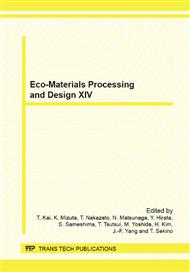p.3
p.7
p.11
p.15
p.19
p.23
p.27
p.35
Evaluation of Electric Power of SOFC Using Reformed Biogas
Abstract:
Biogas of about 60 % CH4 -40% CO2 composition is produced from waste food or drainage. Electrochemical reforming of CH4 with CO2 using a porous gadolinium-doped ceria (GDC) cell is an attractive process to produce a H2-CO fuel used in solid oxide fuel cell. The supplied CO2 is converted to CO and O2- ions by the reaction with electrons at cathode (CO2 + 2e- → CO + O2-). The produced CO and O2- ions are transported to the anode through a porous mixed conductor GDC electrolyte. In the anode CH4 reacts with O2- ions to produce CO, H2 and electrons (CH4 + O2- → CO + 2H2 + 2e-). This process suppresses the carbon deposition from CH4. The formed H2 and CO fuels were supplied to a solid oxide fuel cell with dense GDC electrolyte (Ce0.8Gd0.2O1.9). The open circuit voltage and maximum power density were measured for the reformed gas and for a pure H2 fuel. Little difference in the electric power was measured at 1073 K for both the fuels.
Info:
Periodical:
Pages:
11-14
Citation:
Online since:
July 2013
Price:
Сopyright:
© 2013 Trans Tech Publications Ltd. All Rights Reserved
Share:
Citation:


